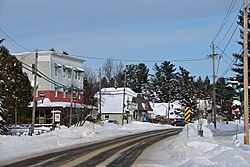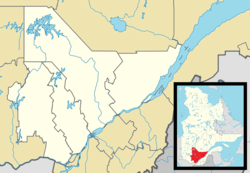Nominingue
Nominingue | |
|---|---|
 | |
 Location within Antoine-Labelle RCM | |
| Coordinates: 46°24′N 75°02′W / 46.400°N 75.033°W[1] | |
| Country | Canada |
| Province | Quebec |
| Region | Laurentides |
| RCM | Antoine-Labelle |
| Settled | 1883 |
| Constituted | October 30, 1971 |
| Government | |
| • Mayor | Francine Létourneau |
| • Federal riding | Laurentides—Labelle |
| • Prov. riding | Labelle |
| Area | |
| • Total | 360.86 km2 (139.33 sq mi) |
| • Land | 303.89 km2 (117.33 sq mi) |
| Population (2021)[3] | |
| • Total | 2,255 |
| • Density | 7.4/km2 (19/sq mi) |
| • Pop. 2016-2021 | |
| • Dwellings | 1,937 |
| Time zone | UTC−5 (EST) |
| • Summer (DST) | UTC−4 (EDT) |
| Postal code(s) | |
| Area code | 819 |
| Highways | |
| Website | www |
Nominingue is a small village and municipality located 200 kilometres (120 mi) north of Montreal, Quebec, Canada, in the Laurentian Mountains. It was formerly called Lac-Nominingue, but changed name on September 16, 2000.
Nominingue is located along Route 117, between Mont-Laurier and Rivière-Rouge, and is near the International Airport of Rivière-Rouge/Mont-Tremblant.
It is surrounded by dozens of lakes, including Petit and Grand Lac Nominingue, Lac des Grandes Baies, and Lac Sainte-Marie, as well as a forest. It is near Papineau-Labelle Wildlife Reserve and Rouge-Matawin Wildlife Reserve. The village was established in the late 1880s by pioneers sent by Curé Labelle to develop this mountainous and wild region. It was once the last station of the famous "P'tit train du Nord" (Little train of the North), until it was extended to Mont-Laurier in 1909. The former Canadian Pacific Railway station in Nominingue is now a small museum and rest stop for cyclists. Golf, disc golf, biking, fishing, and hunting are among the most popular outdoor activities.
The name Nominingue comes from an Algonquin word meaning "vermilion" or "red ochre", referring to a variety of red chalk found in the area.[1]
History[edit]
In March 1883, the first settlers arrived from Montreal. By the following year, its first sawmill and flour mill was in operation.[4] And in 1884, the parish of Saint-Ignace-de-Loyola-de-Nominingue was established, served by Jesuits until 1891. In 1887, its post office opened under the name Nominingue.[1]
On September 15, 1904, the Village Municipality of Nominingue was formed by separating from the Township Municipality of Loranger.[5] This township was created on June 15, 1896, out of unorganized area,[6] and named after Louis-Onésime Loranger.[1]
The Municipality of Loranger-Partie-Sud-Est was founded on April 29, 1920, when it split off from the Township of Loranger. It was renamed the following year to Lacaille, after its first mayor, then in 1931 to Bellerive, and renamed again in 1962 to Bellerive-sur-le-Lac.[1][7]
The Municipality of Lac-Nominingue was formed on October 30, 1971, through the amalgamation of the Village Municipality of Nominingue, the Township Municipality of Loranger, and the Municipality of Bellerive-sur-le-Lac. On September 16, 2000, it was renamed to Nominingue since there no longer was a Lake Nominingue (this lake was renamed shortly before to Grand lac Nominingue).[1][8]
Demographics[edit]
| 2021 | 2016 | |
|---|---|---|
| Population | 2,255 (+5.5% from 2016) | 2,137 (+5.8% from 2011) |
| Land area | 303.89 km2 (117.33 sq mi) | 307.48 km2 (118.72 sq mi) |
| Population density | 7.4/km2 (19/sq mi) | 7.0/km2 (18/sq mi) |
| Median age | 61.6 (M: 62.4, F: 61.2) | 58.3 (M: 59.2, F: 57.3) |
| Private dwellings | 1,937 (total) | 1,937 (total) |
| Median household income | $47,232 |
|
| ||||||||||||||||||||||||||||||||||||
| Source: Statistics Canada | |||||||||||||||||||||||||||||||||||||
Private dwellings occupied by usual residents (2021): 1,176 (total dwellings: 1,937)[3]
Mother tongue:
- English as first language: 0.9%
- French as first language: 94.8%
- English and French as first language: 0.7%
- Other as first language: 3.6%
Local government[edit]

List of former mayors:
- Rosaire Sénécal (...–2005)
- Serge Croisetière (2005–2009)
- Yves Généreux (2009–2013)
- Georges Décarie (2013–2021)
- Francine Létourneau (2021–present)
See also[edit]
References[edit]
- ^ a b c d e f "Banque de noms de lieux du Québec: Reference number 363420". toponymie.gouv.qc.ca (in French). Commission de toponymie du Québec.
- ^ a b "Répertoire des municipalités: Geographic code 79030". www.mamh.gouv.qc.ca (in French). Ministère des Affaires municipales et de l'Habitation.
- ^ a b c "Nominingue, Municipalité (MÉ) Census Profile, 2021 Census of Population". www12.statcan.gc.ca. Government of Canada - Statistics Canada. Retrieved 30 June 2022.
- ^ "Histoire". www.municipalitenominingue.qc.ca (in French). Municipalité de Nominingue. Retrieved 30 June 2022.
- ^ "Répertoire des entités géopolitiques: Nominingue (village) 15.9.1904 - 30.10.1971". www.mairesduquebec.com. Institut généalogique Drouin. Retrieved 30 June 2022.
- ^ "Répertoire des entités géopolitiques: Loranger (canton) 15.6.1896 - 30.10.1971". www.mairesduquebec.com. Institut généalogique Drouin. Retrieved 30 June 2022.
- ^ "Répertoire des entités géopolitiques: Bellerive-sur-le-Lac (municipality) 29.4.1920 - 30.10.1971". www.mairesduquebec.com. Institut généalogique Drouin. Retrieved 30 June 2022.
- ^ "Répertoire des entités géopolitiques: Nominingue (municipalité) 30.10.1971 - ..." www.mairesduquebec.com. Institut généalogique Drouin. Retrieved 30 June 2022.
- ^ "2021 Community Profiles". 2021 Canadian Census. Statistics Canada. February 4, 2022. Retrieved 2022-06-30.
- ^ "2016 Community Profiles". 2016 Canadian Census. Statistics Canada. August 12, 2021. Retrieved 2022-06-30.
- ^ "2006 Community Profiles". 2006 Canadian Census. Statistics Canada. August 20, 2019.
- ^ "2001 Community Profiles". 2001 Canadian Census. Statistics Canada. July 18, 2021.
External links[edit]
 Media related to Nominingue at Wikimedia Commons
Media related to Nominingue at Wikimedia Commons- Official site

